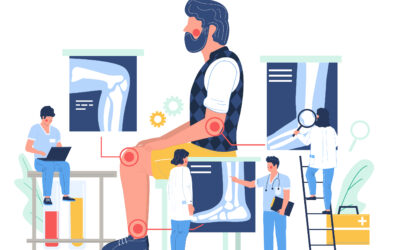Article Written by Tim McGonigle, PT
In the last newsletter an overview was provided regarding the benefit from becoming more proactive in one’s back care with lots of generalizations about mindset and a few practical tools were offered. You may be thinking, “Where’s the beef? Tell me in detail what I need to do.”
Being a health minded nutrition consumer I’ll be glad to “spill the beans”. I’ll start with some easy to apply suggestions for creating a productive mindset and some easy actions to take. There are many facets to managing lumbar issues and if we told you all we know about managing lumbar problems all at once it might burn off both your ears. So, to save you from having charred ears, the next few FPT newsletters will offer a series of steps you can take to preserve and enhance the health of your lumbar tissues. Remember, without challenge, things decay. With too much challenge things fall apart. In the end it comes down to keeping stresses within the tolerance and remodeling capacity of your tissues to prevent breakdown from occurring.
Mindset – The Foundation Of All Actions
Even though this section may appear to be a personal affront to some, please know that it is written with the utmost compassion and understanding that our error in processing situations and events is driven by human nature, not your isolated individual deficits.
Most of us cling to what is familiar, and we yield to social norms. We often function off the way we think things should be instead of the way they are. We are driven by irrational justifications to push boundaries. This is often why it is so hard for people to be open to changing their mode of action when a back problem occurs. It is natural to resist when our wants, thoughts and beliefs are challenged. This is why we use stories and analogies to influence people’s perspective as they can be subtle ways of getting a point across and facilitating a change in one’s mindset without direct confrontation. Once perspective broadens, changes in thoughts and beliefs come more easily. Without full buy-in, advice will be dismissed or taken halfheartedly and little change in people’s mode of operation will occur. Often the two biggest challenges we face in the clinic are to either get the client to fully participate in their care and/or to stop perpetuating their problem by overchallenging their tissues and systems during their activities of daily living so healing can occur.
Below are a few stories and analogies we frequently use to help people make the transition from resisting the acceptance of their current situation and irrationally searching for a resolution to the much more productive ongoing management over time mindset that leads to success in these matters.
Several years ago a friend of mine with a Ph.D. in Sports Psychology gave two terrific presentations at our free informational evening talks. One point he made was that in Western Cultures we are taught to analyze things as being either “good” or “bad”, so if something isn’t the way we think it should be we get caught in this trap of perseverating about how it shouldn’t be so. This leads to irrational justifications of unproductive responses to a situation. He said that in the Eastern Cultures they have a fundamentally different response to the way things are. They have a saying, “And so it is.” They spend their time adjusting to the situation and moving forward as we waste a lot of time and energy digging our heels in, wishing it wasn’t so and compounding the issue with unproductive thoughts and actions. We know this is just human nature and our cultural norm. We witness so much time and energy wasted while we try to convince people with back pain to get fully on board with the program and to stop resisting reality. After getting their back issues under control many have reported that they wished they had seen the light earlier as being on the other side of it allows them to see that Mother Nature just kept repeating the message and patiently waited for them to hear it. If they would have just responded to her first message they would have gained control of their back problems much quicker. We are just articulating her message and hoping people catch on sooner rather than later.
As stated in the last newsletter, it all comes down to keeping weight bearing (axial loading) and position forces within the tolerance of the lumbar tissues through ergonomics, body mechanics and pacing activities with recovery time, and enhancing the tolerance of the tissues through a healthy lifestyle and exercise.
I was explaining this to an engineer years ago and he said, “I totally get it. We test things with the stresses they will be subjected to prior to going to production to assess the chance the item might fail before its warranty is out. If it passes the test, we say the stresses are within the product’s ‘Shmoo’ and it goes to production. If not, we either have to create a situation in which the stresses it will be subjected to are less so that they will remain within the tolerance of the current system (ergonomic adjustments or change in body mechanics), or make the product more robust so it will tolerate the demands asked of it (enhance health of tissues, circulation and motor control).” Your tissues and systems are just like everything else in the physical world and function by the laws of physics and physiology. The only difference is that your tissues have the capacity to remodel and are at the mercy of the mind which can repeatedly cause tissues to be pushed beyond their breaking point. Accepting the reality of the physical laws is the starting point of gaining control over lumbar issues. Making this acceptance harder is the reduction in stress tolerance that occurs with age or after trauma. We often get caught in the mental game of wishing for the former tolerances instead of adapting to the new.
These analogies seem to resonate with people and help them make the critical mindset change from wishing it wasn’t so to accepting the physical reality so they can move forward with gaining meaningful control of their back issues.
Checkbook Theory
Everyone that walks into our building is looking to get back to carrying out their desired activities without giving their backs a thought. The resolution they seek implies unlimited tolerance without maintenance. While it is understandable, it is not productive. Everything in nature involves a give and take. When did you eat last, when will you have to eat again? When did you sleep last, when will you have to sleep again? If it doesn’t rain long enough, we will have a drought. With our health people are often shielded from this give and take early in life as many are born with health in our tissues and things function well without us having to give them a thought until the health starts wearing thin and discomfort starts to creep into life’s equation.
To help people accept the give and take occurring in lumbar tissues that are losing tolerance for previously tolerated activities we use the silly analogy of comparing our bodies to a checkbook. The theory goes like this:
Most of us were born with healthy tissues, or “money in the bank”. We spend, spend, spend against the account without concern until trouble starts to happen (running low on funds or dipping below zero into a deficit) due to wear and tear or an injury. As this has not happened before we think it’s a fluke. We temporarily cut down on our activities (mitigate spending) and spend a little more time lying down (make some deposits) and the discomfort goes away (drift above zero in the account). As soon as we feel better, we stop doing what helped and go back to our previous activity level and the deficit returns. The pattern repeats and becomes more frequent and cumbersome. As our spending outpaces our deposits a gradual decay occurs resulting in less time above zero and with greater deficits to overcome (more frequent and severe bouts of back pain).
The pattern usually goes like this:
Our backs usually give us a warning with a feeling of fatigue, which we can easily ignore. We persist with our activity and the fatigue turns into an ache, which we can also ignore. As we continue and the deficit grows the ache worsens and turns into pain and we think, “This isn’t the way it’s supposed to be. I’m not giving in to this”. We push ahead until the pain forces compliance when the bill collector is pounding on the door threatening to break our legs if we don’t pay up. As we don’t want our legs broken, we behave. We stop the aggravating activity (stop our spending) and we figure out how to make some deposits by lying down, icing, taking some over the counter meds, seeing a practitioner. With the control of spending and the input of deposits the pain reduces. As soon as the discomfort becomes manageable or we start having some pain free time we think, “I must have hit the lottery and my account is full again!”. We rush to make up for lost time and resume the aggravating activity at breakneck speed and stop making deposits until the bill collector returns. By doing so the structure of our backs become weaker so it takes less stress to cause more trouble. Unless people see the give and take and figure out how to outpace their spending with deposits the trend will continue to be negative.
Gaining control simply requires outpacing spending with deposits. It is hard to convince people that the plan is not to overspend during the day and try to play catch up at night. The quickest way out of trouble is to seek being more comfortable all the time and to actually feel better by the end of each day as the deposits have outpaced spending. If the pain is constant, the goal is to have it reduce in intensity. If being pain free is possible, the goal is to make deposits before fatigue starts as fatigue indicates the beginning of a deficit. The overall goal is to be so proactive that the person is no longer hovering around the breakeven point and that they have restored a “cushion in the bank” so the balancing act is not so tedious and if a big event occurs there is enough tolerance in the tissue to cover it without dipping below zero. It also reinforces the idea that maintenance should be ongoing as even if you have $100,000 in the bank you can spend it over time if you never replenish the account. The math is the same no matter where the account is. If a task takes $10,000 out of the account and you have $100,000 in it the expense isn’t painful, but the account is not as robust as it was prior to writing the check. If you only have $10 in the bank (no pain because above zero, but also no cushion) and you spend $10,000 it comes with a severe penalty. The expense is the same but in one case the money was put in before the check was written and the other had to make up for it after the fact.
By understanding how to “make deposits” and assess the “expense of an activity” people have a method of understanding, and predicting, the behavior of their symptoms and methods of controlling them.
Accepting Functional Capacity
The other analogy we often use to get people on track is taken from Stephen Covey. He says that one of the reasons businesses (and people) fail is that their production desire outpaces their capacity and their resources get overextended. The analogy he uses to make his point is the desire to drive from SF to Reno and only having enough capacity in the gas tank to get to Roseville. He says that if you understand that is the capacity you pull off the freeway in Sacramento, fill your tank and drive the rest of the way to Reno without incident. You don’t have to like the inconvenience of having to stop but doing so allowed the trip to go well. If you don’t accept your limit, you drive past Roseville and run out of gas before you get to Auburn, and it ruins your day. You get out of your car, kick the tires, walk to a gas station, are late for your meeting, leaving everyone upset.
The reality of your tissue’s tolerance is what it is and you are the one who is driving. You don’t have to like the limits, but to move forward you do have to accept them. If they are not the limits you want, you will either have to work to get a more efficient motor (better ergonomics, body mechanics, circulation and motor control) or develop a bigger gas tank (healthier, tougher tissues). Even as your situation improves you have to accept that there will always be a limit, so putting money in the bank, or gas in the tank, while there are still resources available is a much better way of living than repeatedly creating a deficit and having to pay the price.
These two analogies have such value. They make the situation clear. They diffuse all excuses. They assign responsibility to the only one who is capable of controlling “the account”. They empower people to be the master of their fate.
It All Comes Down to Four Choices:
If there is a situation that will challenge your tissue’s tolerance there are four options a person has to choose from.
01. They can perform the task and pay the price. This comes with three options.
- They can write the check, experience a flare and then have to spend the time icing, tractioning, resting, exercising long enough to make up for the deficit.
- They can preload the account by icing, tractioning, exercising and resting to “put enough money in the bank” to cover the check they are about to write. Or,
- They can pace their activities with intermittent periods of self-care to make the appropriate deposits to cover the checks they are writing as they go.
- They can mitigate the cost by finding another way of getting the task done through:
- Improved ergonomic changes
- Using more protective movement patterns (altering body mechanics)
- They can get someone else to do it.
- “If you vacuum, I’ll pick up Johnny from school”
- They can leave it alone. It just might not be a wise use of limited resources to wash the car, clean the house, work in the yard or golf with friends as there may be much more important tasks to get done.
In reality, there is no other option. Making this clear has helped so many of our clients over the years as someone has finally informed them of the rules and given them options. It is not our place to tell people how to live, but it is our job to make it clear what the give and take of their choices are so the fluctuation in their back pain is no longer a mystery and they are empowered to be in control. So much of our irrational processing comes from the fear and anxiety of not feeling a sense of control. Being empowered is a powerful thing!
Practical Application
Remember, there are two mechanical forces that play on your back. These are the compression that occurs with axial loading from weight bearing and end-range position forces. Management of axial loading consists of mitigating the intensity and duration of compressive forces (weight bearing that occurs during sitting upright, standing and lifting or carrying something) and the management of position forces is achieved by minimizing end-range positions during activity and rest. When structures are taken to their end ranges, tensile and compressive forces are much greater than when structures are positioned in more slackened, mid-range positions and supported either passively by an external support or actively by protective muscle contractions.
Creating a “Back Friendly” environment is easy and once done you are set for “less expensive” activities of daily living without expending much effort. Examples include:

Placing a support under your knees and head/neck when supine

Placing support under your abdomen and ankles when prone

Placing support between knees when side-lying

Reclining car seat (be mindful that this changes the “blind spot”)

Getting reclined when performing work, computer work, watching TV, talking

Drape over a gym ball for work, gardening, playing with young kids, changing a diaper, etc.

Using a saddle chair and “high-low” desk to open the thigh-torso angle and raise the monitor for desk work
Other easy adjustments include:
- Keeping the pots and pans most often used on the stovetop instead of feeling obligated to put them away under the counter
- Putting your most frequently worn shirts, socks, underwear in the top drawer of the dresser
- Wearing slip-on shoes
- When loading the dishwasher, rinse the dishes and place them on the counter above the dishwasher, go down on one knee once and load the dishwasher from there
- Prepare for an upcoming trip or family event well ahead of the start so your bags are packed, or the house is clean, a few days prior allowing for rest and binging on self-care to bolster the account for the extra spending that will occur. Plan self-care time and sneak in some sly self-traction and muscle bracing during the event so you can enjoy it without your back discomfort.
- When swinging the clothes from top-loading machines, post one hand on the top of the washer and use the other hand to move the clothes. With front loading machines, put risers under them and go down on one knee to swing the clothes.
- During activity, set a timer and pace activity time (checks) with rest or self-care (deposits). Easy method of making deposits for most backs include:
- Getting non-weight bearing or reclined with good neck and back support
- Performing self-traction and “bracing” with your shoulder girdle, trunk and hip girdle muscles while the lumbar spine is in its most comfortable position.
Easy examples include:

Hook-lying decompression with ball

Supported on ball decompression

Hook-lying pull on towel

Hook-lying decompress/bracing off thighs

Feet on floor door traction

Decompress off arms of a chair

Decompress and brace off of a walker, countertop, car fender, etc.

Decompress/brace off desk/tabletop, steering wheel and console in the car, etc.
The idea is to outpace spending with deposits. I know it’s almost too simple to be true, but it is the only way of getting the account to be healthier, and it works. The sooner you become proactive in your care, the sooner you will gain control.
Two Stories:
The Kayaker
I treated a high-level kayaker with two bad discs in his lumbar spine that were creating a lot of trouble for him. I first tried to convince him that he should take up another recreation activity as long-sitting in the kayak and twisting his back were such “huge checks” against his “account”. He insisted that we try to make it possible. He was a terrific patient and did everything I asked. His back pain subsided. I ran into him at the end of the summer and asked how his back was doing. He said, “Great. And I’ve been able to kayak!” I said, “No kidding?” He said, “But I’ve paid my dues. I’ve arranged everything in my house and office so nothing gets below my waist to save me from bending to save the tolerance for kayaking. I train an hour a day exactly the way I was instructed. I traction my back 1,000 times a day as I’ve found I can decompress off of about anything, and I ice my back once a day whether I feel like I need it or not.” He said, “I’ve been kayaking five times without trouble, but once as I got in the boat I could feel my back was not up for the task, so I got out and went home. Thinking back on it, I had had the ‘flu two weeks before and I think it had drained the account enough that there was no cushion in the bank for a recreation activity.”
I ran into him at soccer tournaments over the next ten years. Each time he reported staying with the routine and enjoying a fully active life with minimal back problems. If his back gave him a warning the account was getting low, he curbed his activity and increased his deposits without disgruntlement.
One day he limped into the practice. I said, “What happened?” He said, “I changed jobs, my commute got longer, I stopped working out and I gained 30 lbs.”. I said, “What about tractioning 1,000 a day and icing once a day whether you thought you needed it or not?” He said, “I forgot all about tractioning and I haven’t iced in 4 months.”
He wanted a “high expense” lifestyle and for 10 years he willingly created a prudent and high-income lifestyle to afford it. The plan worked great, until he stopped working the plan.
“The Best Garden I’ve Ever Had”
I treated a terrific 40-year-old woman with a very bad neck and back. Like the kayaker, she bought into the program and gained very good control over her spine pathology. One day I ran into her in a store. She told me she had the best veggie garden she has ever had because she paced herself so well. She said, “I work in the garden for 20 minutes, and I take a break. I work for 20 minutes, and I take a break. I’ve been able to tend the garden consistently all season and it is beautiful.” She said before catching onto the “Checkbook Theory” her mode was to work vigorously all day in the garden at the beginning of the season, flare her back or neck, spend the next three weeks in bed and her garden was a disaster.
It Takes A Calm Mind To Hear The Message
Your back will tell you this is right. You just have to listen to it, stop the irrational resistance that is causing you to perpetuate your trouble and think some medical practitioner can produce a resolution that will allow you to not follow the laws of physics and physiology.
A Word Of Caution About A Common Mistake
It is a very common pattern that once people start gaining control over their lumbar pain and have progressed to some advanced strengthening and cardiovascular exercises their back pain starts to become less manageable again. Upon questioning, they have stopped controlling axial loading and pacing their activities with rest/self-care. Once they resume this aspect of their management the back pain reduces. Aggressive exercise builds the strength and endurance to make activities a smaller check, but without deposits even less spending per minute can drain the account. You have to keep mitigating both axial loading and position forces to exercise all of the variables within your control to manage your musculoskeletal health.
Many tell us that they can golf, play tennis, etc. once or twice a week and keep control but that it is not worth the deposit time to participate more frequently. The choice is yours. Without unencumbered acceptance of the situation and a willingness to assume the ultimate responsibility for day-to-day management an optimal outcome will remain elusive. Do the math from where you are, not where someone else is, or where you used to be, or where you wish you were. If you want to get to Chicago and you are standing in Sacramento, it’s not much help to plan your trip from Phoenix. Be the master of your fate and the captain of your soul. Get outside help when you need it but don’t be dependent on someone else to control your account.










